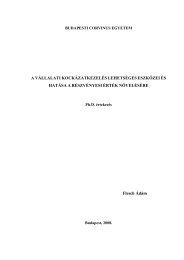Jenei István
Jenei István
Jenei István
Create successful ePaper yourself
Turn your PDF publications into a flip-book with our unique Google optimized e-Paper software.
<strong>István</strong> <strong>Jenei</strong>: Lean transformation of hospital processes – Structuring foreign and Hungarian experiences,<br />
PhD Dissertation, Corvinus University of Budapest, Doctoral School in Business Administration<br />
TPM, respectively, and of their interactions, on production performance. They review<br />
19 literature items: “The empirical studies that we draw upon are studies in the last 10<br />
years that have sufficient grounding in the literature and assessment of measurement<br />
used in empirical analysis.” (Cua et al., 2001. p.676.). They divide the “components”<br />
associated with each area into four parts: TQM-specific, JIT-specific (Lean), and TPM-<br />
specific components and “common” ones. They sum up their findings in spreadsheet<br />
format. Of the four categories, the TQM, JIT (Lean) and “common” components are<br />
important for us here. These are shown in Column 3 of Table 1.<br />
A look at the fields of the Table 1, shows that the analysis of Cua et al. (2001) of<br />
the common and different components, respectively, of JIT and TQM rhymes in many<br />
respects with the findings of a similar survey by Flynn et al. (1995). As far as these two<br />
sources are concerned, not only the practices themselves (which are not presented in the<br />
table), but also their category labels correspond to one another to a large extent. The<br />
terminology of Shah –Ward (2007) is different, albeit the practices concerned are<br />
remarkably similar. Surprisingly, Shah –Ward (2007) identify as lean management – in<br />
addition to the components of JIT – also practices assigned to TQM by the other two<br />
sources. This variance affirms that (i) there is no consensus in the technical literature<br />
either as to the assessment of the various practices and (ii) Lean (lean management) is<br />
developing, and its content keeps expanding (Hines et al., 2004).<br />
According Hines et al. (2004), lean management as a first stage of the<br />
identification of the system focused primarily on the production area and especially the<br />
tools which organise the material flow (JIT, kanban) in the strict sense. The extension of<br />
such solutions to without the company limits, e.g. to the suppliers, came in a later phase.<br />
This is how we should interpret the inclusion of a supplier JIT among the JIT-specific<br />
tools in a paper written in 2001. By and large the same applies to strategic planning,<br />
included among the common components. This, too, is an instance of JIT/Lean<br />
development, in the sense that the users increasingly recognise the strategic relevance of<br />
the system, and its close relationship with strategy creation. The change in terminology,<br />
namely that instead of making a distinction between JIT and TQM, the companies<br />
which applied both started to call them, comprehensively, lean management, is probably<br />
attributable to the same development. The underlying rationale is that all of these<br />
components were typically present in the production systems of “Lean” Japanese<br />
companies. Thus when the authors of “The Machine that Changed the World” (Womack<br />
- 27 -

















